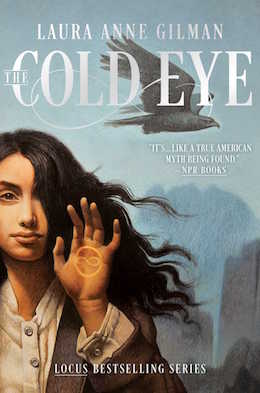The Cold Eye is Laura Anne Gilman’s second novel in her “The Devil’s West” series, following on from Silver on the Road. Isobel of Flood, the Devil’s Left Hand, is still riding the devil’s Territory in the company of her mentor on the road, Gabriel Kasun. Her job is to protect the Territory, and the devil’s Agreement that keeps the peace between the land, the native peoples, and the white settlers.
Isobel survived her first real trial as the Devil’s Left Hand in Silver on the Road, stopping a nasty pile of magic and malice stirred up by Spanish priests to whom the devil is an eternal foe instead of a creature of power bound by his own rules. But scant time has passed before Isobel is faced with her next problem: The Cold Eye opens with dead buffalo and a sense of wrongness that draws Isobel from the Road that winds through the devil’s territory. In the hills, the land shakes, and the animals have fled. There’s trouble there, and Isobel’s connection to the bones of the Territory—and Gabriel’s talent for finding water—is disrupted by it.
Meanwhile, Gabriel is hiding a secret in the form of a letter from a friend in the United States. The new president, Jefferson, has his eyes on the Territory, and while Gabriel doesn’t think the US’s interference will have much effect on the devil’s land—nor does he want to get involved—he may be wrong. Men from the US have no real idea of the dangers and the rules of the Territory, and they may cause as much difficulty through ignorance as intent.
What can I say about The Cold Eye? It would probably make a visually gorgeous film, full of long shots of landscapes and weighted, meaningful silences. It’s big on scenery and landscape, and scenery as metaphysics, landscape as the backbone of myth. If it had energy and character to match its geopoetics, it might have turned out to be a really good book. Unfortunately, we spend the vast majority of our time with all of two characters, the viewpoint characters Isobel and Gabriel, solitary in the wilderness. And in The Cold Eye, they have the charisma and narrative chemistry of a pair of damp blankets.
I really wish it weren’t so. But due to the nature of Gilman’s setting and narrative choices, the only other characters are very minor players. That puts the whole weight of the narrative onto Isobel and Gabriel, and their shoulders aren’t quite broad enough to carry the load.
It might be a different case if The Cold Eye had a less measured pace—one might say a less glacial pace, considering how very tied to its landscape it is. But it meanders around to wherever it is going: the plot mostly seems to involve travelling places because of vague hints and feelings that something might be wrong, peering at metaphysical activity and/or scenery, saying “I don’t know what this is,” and “I don’t know how to fix it,” poking at it for a while before going someplace else, meeting people and/or spirit animals who’re mysterious and unhelpful, realising that more Wrong Things are connected to the initial Wrong Thing, and proceeding to poke at the metaphysics until a mysterious revelation or set of circumstances or heretofore unknown talent allows Isobel to fix what’s broken—frequently without understanding exactly what she did. As a novel, The Cold Eye feels peculiarly aimless. I found myself caring less and less about Gabriel and Isobel and their problems as the novel progressed, because if they don’t know what’s going on, and I don’t know what’s going on, and they are about as interesting to watch interact as a kettle is to watch boil… why am I here, again?
It’s entirely possible that I’m made of crank and resentment, and that’s why my reaction to The Cold Eye is a thoroughly resounding “meh.” I did finish the novel, so it’s not all bad news. The prose is fine. When Isobel and Gabriel show flickers of character and charm, there’s the hint of a promise of what could have been, in a novel less filled with empty spaces. There’s definitely enough of interest here to fill a short novella, and the metaphysics and sense of place are fascinatingly intriguing. But that’s just not enough to leave me feeling remotely satisfied with the experience
And, damnit, I really wanted to like it.
The Cold Eye is available from Saga Press.
Liz Bourke is a cranky queer person who reads books. She holds a Ph.D in Classics from Trinity College, Dublin. Find her at her blog. Or her Twitter. She supports the work of the Irish Refugee Council and the Abortion Rights Campaign.










